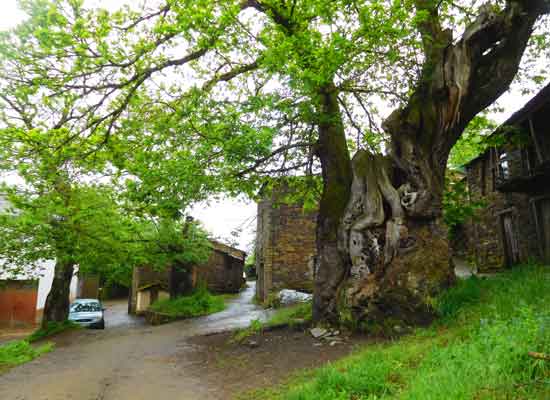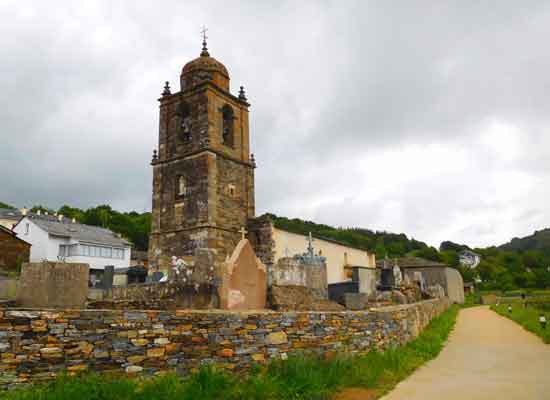Step by Step along The Way of Saint James
From O Cebreiro to Triacastela
6 June 2018
Stage 27 – Km. 22

The Way of Saint James often tests us pilgrims, presenting us with very demanding stages where the greatest effort is required more from our willpower than from the strength of our legs.
It’s like a strict father who, however, knows how to reward those who conquer the toughest challenges with commitment and determination, later offering simpler and less strenuous routes as a prize.
After yesterday’s exhausting journey, classified as one of the most difficult stretches of The Way, today we will be rewarded with an easier route. The first part features some gentle ups and downs, followed by a steady and calm descent until the end of the stage.
Moreover, the total kilometres to be covered are below the daily average, and by the end of the route, we will have walked just over twenty-one kilometres.
Given the short distance ahead, once we reach our final destination in Triacastela, we will decide whether to continue to Samos—an additional ten kilometres to the route already planned.
– Quite a difference! –
We set off again this morning at 6:30.
As soon as we step out of the hostel, we are greeted once more by the usual drizzle, the usual cold, and, as if that weren’t enough, the fog, which in this part of The Way is becoming just as “usual.”
During the first few kilometres, visibility is very limited.
The rural landscape we pass through is shrouded in a white cloud of mist that creates a “flow” effect, while much of the beautiful hilly scenery, made up of smooth green curves, remains hidden from view.
Beauty, however, can also be found in such a muffled environment, provided one tries to observe with the soul what is impossible to see with the eyes.
The path we walk along seems to end just a few dozen metres ahead, swallowed by nothingness. We see trees, rural churches, stone cottages, and grazing animals appear and disappear in sequence. It feels like watching a slideshow, where the transition between one image and the next happens with a fade effect.
After leaving O Cebreiro and walking for over an hour, covering about four and a half kilometres, we arrive at Alto do San Roque. We are 1,270 metres above sea level, eight hundred metres past the village of Liñares.
Since 1993, this spot has featured an imposing bronze sculpture depicting a pilgrim struggling against a strong and contrary wind.
The dramatic intensity of the scene, made very lifelike by Galician sculptor José María Acuña, is expressed in the figure’s posture: the body bent forward, the left hand firmly holding his hat to prevent the wind from carrying it away. The folds and flaps of his garments further emphasize the force of the gusts hitting the traveller.
On clear days, this is a panoramic point offering views of the hills and valleys below; today, however, we have to settle for barely glimpsing the sculpture.
Despite the poor visibility, we make sure to take several photos of the statue to commemorate our passage through Alto do San Roque.
Remaining largely at the same altitude, the route continues with gentle ascents and descents.
By around eight o’clock, we reach Hospital de la Condesa.
The word “Hospital” in the village name indicates its historical significance as a place of hospitality for pilgrims, while “Condesa” refers to Countess Egilo, who founded the hospital around which the village later developed in the 9th century.
The village church, dedicated to Saint John, like others in the area, has a stark Romanesque style, with stone masonry walls and a tower accessible via an external staircase.
After Hospital de la Condesa, the final slight climb of today’s stage begins: a stretch of just two and a half kilometres with a rise of about sixty metres.
This leads us to Alto do Poio, which, at 1,335 metres, is the highest point in Galicia along the French Way.
We are higher than O Cebreiro, and from here too, one can enjoy a pleasant panoramic view.
The sky has cleared a little, and the fog has almost disappeared.
Upon arriving in the village, a faint sun encourages us to shed a layer of clothing despite the brisk air.
After this last climb, we stop at the bar attached to the Albergue del Puerto to catch our breath and have something to eat.
It’s almost nine when we leave Alto do Poio.
From here, the descent begins—a route of about thirteen kilometres that will take us to Triacastela.

Arriving in Fonfria, a sweet and cheerful-looking elderly woman stops us in front of her house to offer us crêpes, which she keeps stacked on a plate covered by a cloth.
Always hungry, we see them as manna from heaven and gratefully accept.
As we take and eat the crêpes, she sweetens each one by sprinkling powdered sugar on top.
Although the elderly woman’s offer is entirely free, we make sure to thank her by leaving some money.
This is yet another example, in my opinion, that disproves the idea that The Way of Saint James is just big business.
Being content with a few coins, offered voluntarily, hardly seems exploitative. I’d call it “survival” instead.
Fonfria, like many of the countless remote villages touched by The Way, would most likely be long-abandoned without the many pilgrims passing through daily.
***
Walking along dirt paths, we cross rural landscapes alternating between dense forests and vast open fields.
After the almost clear skies we found at Alto do Poio, the fog has reclaimed its starring role, once again creating that soft and diffused atmosphere.
Due to Galicia’s humid climate, mist formation is quite common in all seasons.
Giulia has already decided not to stop in Triacastela; she will continue to Samos, joining a group of pilgrims with the same plan.
Her decision to walk the additional ten kilometres is influenced by the limited time off work she has taken. By extending some stages, she hopes to complete The Way all the way to Finisterre.
As we continue descending toward the valley, we first pass through Biduedo and, a few kilometres later, Fillobal—passing through both villages without stopping.

Less than a kilometre from Triacastela, in the hamlet of Ramil, we come across a thousand-year-old chestnut tree. It stands out for its massive, gnarled, and irregular trunk, with a circumference of over eight metres.
At 12:15, we arrive in Triacastela, marking the end of today’s planned stage.
Once here, we have no desire to continue and walk another ten kilometres to Samos.
With no rush to reach Santiago de Compostela, we can afford to take it slow and enjoy walking without turning our stages into a race.
Moreover, the drizzly, cold, and foggy weather does little to encourage us to keep going.
The hostel where we decide to stay is called Complexo Xacobeo. It’s a private accommodation, which also includes a restaurant located a few dozen metres away on the same street.
The welcoming complex has about fifty beds.
Recently renovated, it stands out for its extensive use of wood and some exposed stone walls.
Unlike most traditional hostels, the bedding includes blankets and cotton sheets.
After so many nights spent in sleeping bags, it feels like a luxury to sleep in a proper bed.
So, after taking a shower and while waiting for our laundry to wash and dry, we take advantage of the time to enjoy a good afternoon nap.
Around six o’clock, Rocco and I go for a walk to explore Triacastela.
From our first look around, the village doesn’t seem to offer much of interest, so we head to the tourist information office to check if we’re missing any hidden gems.
They point out the pilgrim monument, which, however, leaves us rather unimpressed.
It’s a stone pyramidal trunk with a large red metal cross of Santiago on one side and a small statue of a pilgrim on top.
More than the monument, what catches my attention is the presence of a physiotherapy centre on the village’s main street.
From the outside, it gives the impression of being a very professional and well-organised establishment.
A sign at the entrance reads “Fully Booked.”
I can’t help but smile, imagining that many pilgrims must have flocked there to get their “battered” bodies treated after so many days of walking.

The only structure I find interesting in the village is the small Igrexa de Santiago de Triacastela.
Here in Galicia, rural churches are almost always surrounded by cemeteries, with tombs set against the high walls enclosing the religious buildings.
The church dates back to the 9th century and has Romanesque origins, although significant renovations were carried out in the 18th century.
Externally, the prominent front tower stands out, consisting of three levels plus an octagonal top section.
The lower level features a porch with four arches framing the entrance; the second level has a niche housing the statue of Santiago; and the third level includes semi-arches with bells.
We enter the church just as the “pilgrim’s mass” ends, and the congregation begins to leave.
Inside, the main focal point is the golden altarpiece of the main altar, designed in a moderately Baroque style, with a central statue of Santiago as a pilgrim.
Around seven in the evening, we have dinner at the restaurant belonging to the hostel where we’re staying.
The “pilgrim’s menu,” offered at 10 Euros, includes typical Galician dishes.
To start, I choose “caldo gallego,” a traditional soup usually served hot during the winter months.
Its ingredients include vegetables, beans, potatoes, and sometimes a bit of meat. The recipe for this rustic stew often varies based on whatever ingredients are available at the time.
For the main course, I order a veal steak, and, as always, I finish with the traditional Tarta de Santiago.
We accompany our meal with a good Galician wine, sharing a litre between the two of us.
By nine o’clock, with the combination of wine and the day’s fatigue, we’re already ready for bed.
| © Aldo Lardizzone 2020 |  |
CREATIVE COMMONS |
Stage 28 - From Triacastela to Barbadelo



